
"Swim Noodles" As Dive Markers (Buoys)
by
Larry "Harris" Taylor, Ph.D.
This material is copyrighted and all rights retained by the author. This article is made available as a service to the diving community by the author and may be distributed for any non-commercial or Not-For-Profit use.
All rights reserved
Go To: Home About "Harris" Articles Slides War Stories Editorials Links Fini
"Swim Noodles" are hollow rods of flexible plastic foam (typically about 4.5 ' (1.37 m) x 3" (7.6 cm)) that are commonly sold at pool supply vendors and toy stores. They have a variety of uses around pool environments, but primarily function as buoyancy aids. This article describes their use as home-made marker buoys. This exercise was a result of a personal need for markers used to define a large diamond-shaped navigation practice course. I wanted the markers for the course to be upright, highly visible, and, once anchored, to maintain constant position relative to the bottom. In addition, I wanted markers for submerged base lines and "lost objects."
Single noodles are less than rigid. However, addition of a noodle sleeve (also sold at pool supply vendors) increases the diameter (as well as increasing buoyancy) and gives the overall structure more rigidity. The basic marker was formed by sliding the outer sleeve over the smaller noodle (Armor-All was used as a lubricant). A cross-section (about 4" (10.2 cm) in diameter) is shown below:

However, even with the outside sleeve, the "noodle" is still fairly flexible. But, addition of a 1/8" PVC pipe down the center of the rod provides a rigid, buoyant cylinder.
Ends
Over time and use, the foam ends will deteriorate. To minimize this destruction, the ends were capped with a single plastic disc (below left) that is commonly used as a pool toy. To hold everything together, two 3/16" holes were drilled in the PVC pipe and the entire assembly secured (after the line was fed through the PVC pipe) with 3" machine screws and lock-nuts. The screws, in addition to securing the entire assembly, also provide a mounting point for lights, strobes, sonic "pingers," or other small objects. A polypropylene rope is eye spliced at both ends. The eye splice at each end provides convenient loops for handling, storage, or attachment to an anchor line. The end of the marker is shown below right.
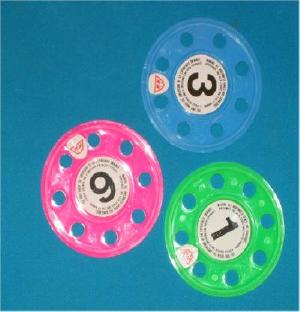 |
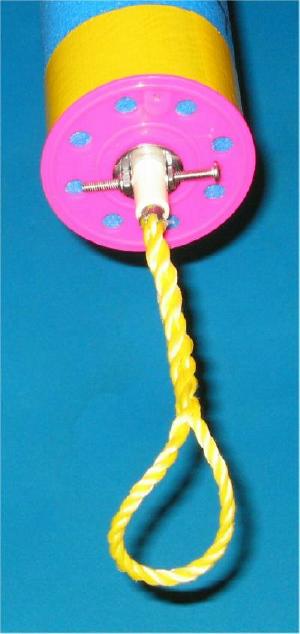 |
| Plastic Disks | Finished Product |
The Buoys
The buoys were made of different colors to contrast with the backgrounds (shore views) found on inland lakes and quarries. The cylinders were marked with colored duct tape and 3M light reflective tape to enhance visibility. Three different colored markers are shown below, left. The markers need not utilize the entire length of purchased "noodle." Indeed, I have used several different lengths dependent on use. Four of these for size comparison are shown below right.
In the right image below, the 4 buoys (Left to Right) are
1. The primary marker buoy, about 4.5' long; it has a buoyant force of approximately 24 pounds.
2. A smaller version, about 3' long used in shallower water; it has a buoyant force of approximately 20 pounds.
3. A short marker buoy with about 20' of line used to mark submerged objects (like baseline in search exercises) in shallow water.
4. A buoy about 1' with 18" of line. This marker is deployed on the bottom as a "lost object" for students to find in search exercises.
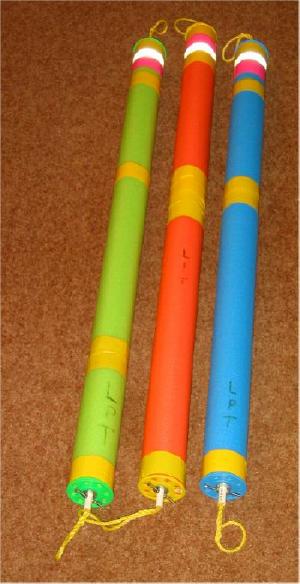 |
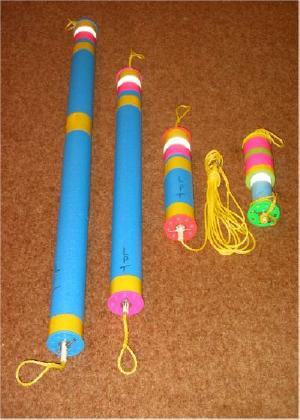 |
|
Completed Marker Buoys |
4 Different Buoys |
Since the primary purpose of these markers is to establish a large array for navigation exercises, it is important that their surface position remain constant. This means the line from the buoy to the anchor must be vertical with minimum scope. To facilitate this, a locking carabineer is attached to the lower end eye-splice. The surface end of the anchor line is then fed through this carabineer (which is pretending to be a pulley) and attached to a four pound weight. The weight (which, for convenience, also has an eye-splice) is shown below left and the completed assembly is shown below right. Once deployed in open water, the weight will pull the line from the anchor taut and the marker will reside directly above the anchor. This system compensates for wind/water movements and allows the marker to remain in a relatively fixed location.
Weight/Pulley
 |
 |
| 4 pound Weight | Carabineer As Pulley |
Noodle as a Plumb-bob
Plumb-bobs are used by divers primarily in underwater surveys. When measuring in three-dimensions, if there are differences in heights of points measured above the reference line, there is always ambiguity as to the true distance measured because of the angle between the reference line and the point measured. For example, if the diagram below represented a cross section of a shipwreck, the baseline (from which all points are measured) would be at point C. If one was determining the position of an object at point A, a direct measurement from the object A to the baseline at point C would be longer than the line AB. Since divers typically do not have a convenient means of recording angles for three-dimensional renderings, divers typically will measure line AB (trying to keep the measuring line as level as possible), and determine point B as being directly above the reference line at point C. A plumb-bob (weighted line) is used to ensure that the line BC is vertical. If the distance of BC is large, compared to AB or AC, then distance BC is also measured to provide a more accurate representation of object A relative to the baseline at point A. Near shore mapping and math of mapping are discussed elsewhere.

One way of dealing with this problem underwater is to make all measurements in the same plane (flat surface) and use a plumb-bob (weighted line) to indicate that the point of measurement is directly above the reference line. Divers use a variety of objects for this ranging from a simple weight on a string to more complex arrangements. Typically, a carpenter's or surveying plumb-bob is attached to a piece of styrofoam and carried in the b.c. pocket of the diver. These are sometimes inconvenient to deploy, especially with cold, dry-suited hands. Also, the sharp point of a plumb-bob might scratch or tear diver's b.c. However, these simple devices are inexpensive and easy to assemble (wrap a plumb-bob twine line around a piece of styrofoam and you are ready to go).
The method of making swim noodle buoys above can be utilized to make a much smaller device. This device, because of its clip is easy to carry, deploy, and recover. Its larger size makes its easier to manipulate with dry suit gloves. If a simple weight is used instead of a plumb-bob, then this device can be used as a diver-carried marker buoy. The parts of an unassembled plumb-bob are shown below
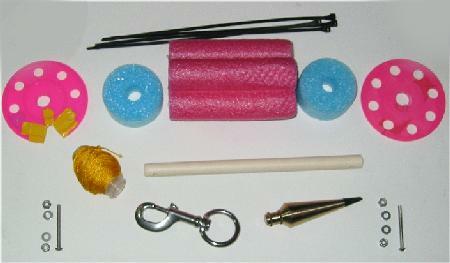
The differences between this device and the marker buoys above:
1. twine, not polypropylene line is used
2. a diver's clip, secured with tie-wraps, is used instead of polypropylene loops
3. a notch has been cut in one of the end plates to facilitate winding the twine (10' , marked at every foot)
The assembled device, ready for deployment is shown below. A piece of bungee cord retains the plumb-bob in place.
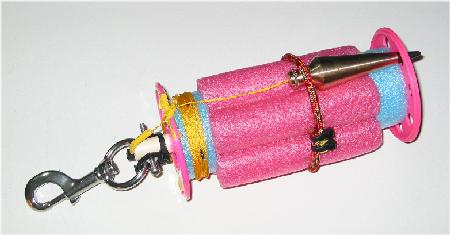
When used, the plumb-bob line is on the same end as the clip. This facilitates straight up-and-down orientation of the float. The line near the attachment point and the notches are covered with a single piece of yellow duct tape as a means of minimizing friction.
Noodle as a Sleeve
Colored duct tape and reflective tape can be added to a noodle to form a sleeve. This sleeve, below left, can be placed over a dive flag shaft, below right, to increase visibility of the diver's flag.
 |
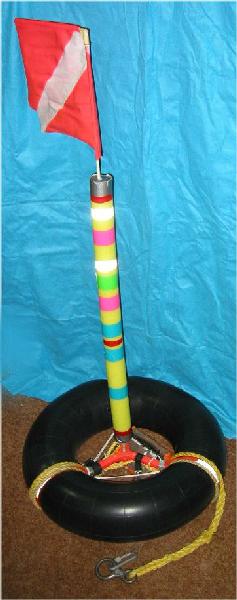 |
| Noodle Sleeve | Sleeve attached to Dive Flag |
Storage
Since noodles are foam, they will tend to bend under weight. To minimize this distortion, the marker floats can be stored by hanging by the upper loop or by storing in the horizontal position. I typically store the large markers objects horizontally, wrapped in threesomes with a large (2" x 18" ) Velcro strap to maintain linear shape. This is also a convenient transport mode.
|
|
 |
| Hanging By Loop | Stored As A Bundle of Three |
Conclusion
Swim noodles, with a little modification can be converted to a reasonable diver marker buoy system. These buoys are not intended for long-term use in turbulent waters, but they will provide a convenient short-term marker in relatively calm water.
Go To: Home About "Harris" Articles Slides War Stories Editorials Links Fini
About
The Author:
Larry "Harris" Taylor, Ph.D. is a biochemist and Diving Safety Coordinator at the University of Michigan. He has authored more than 200 scuba related articles. His personal dive library (See Alert Diver, Mar/Apr, 1997, p. 54) is considered one of the best recreational sources of information In North America.
All rights reserved.
Use of these articles for personal or organizational profit is specifically denied.
These articles may be used for not-for-profit diving education